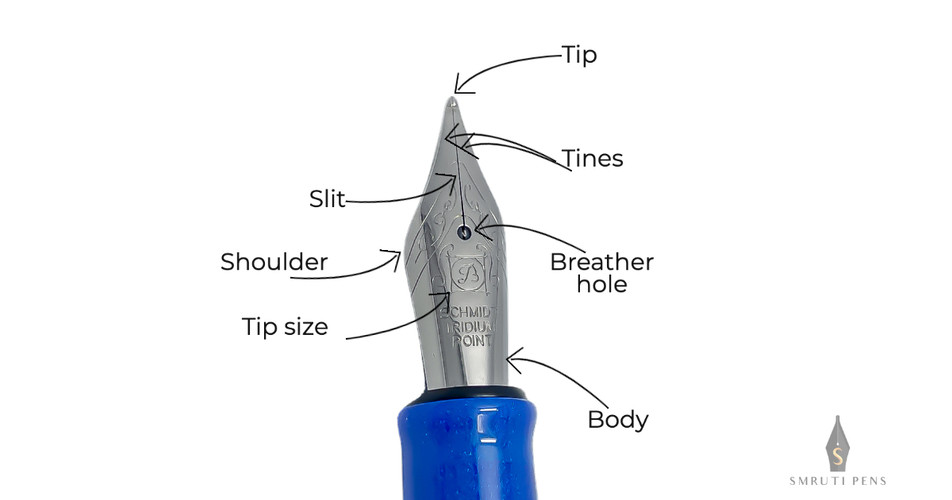Posted by Smruti Pens on 27th Nov 2022
Introduction to Fountain Pen Nibs
In this post, we want to cover the basics of fountain pen nib to enable you to find the perfect nib for your writing needs. If you haven’t guessed it already, the nib of the fountain pen is the thin metal part of the pen that touches the paper and can make all the difference in the writing experience. Before we dive into the details of the nib, the image below shows the anatomy of the nib, as well as information that is also generally found on the nib itself:
Tip Characteristics:
When it comes to the tip of the nib, there are two important characteristics to consider - the shape and the size of the tip:
- Tip Shape
There are two major tip shapes. The first and the most commonly used tip shape is round. This is the most widely used shape because the round shape creates uniform lines on paper regardless of how the nib touches the paper. This is a great choice for beginners to start with. The second major tip shape is called italic or stub. This tip is wider and flatter. This adds dimension to writing as the horizontal and vertical strokes will have different widths.This type of tip does take some practice to get used to, and can produce great results once mastered.
- Tip Size
Tip size is an important choice when purchasing a fountain pen. The tip size determines how wide of a stroke the pen writes. Common tip sizes for round nibs from narrow to wide are Extra Fine (EF), Fine (F), Medium (M), and Broad (B). Smaller tip sizes are great for everyday writing, or for people with smaller handwriting. And since they lay down less ink they are also easier to use with any paper. The wider nibs are great for more expressive writing as they write bolder, and will display the features of the ink beautifully on fountain pen friendly paper like Tomoe River paper.
While the above are common sizes for rounded tips around the world, note that the nibs from Japanese manufacturers tend to write narrower than the same sizes found in western nibs. The actual line width on paper can also vary a little due to the type of ink or paper used or the angle at which the pen is used.
For italic tips, common sizes are medium italic (MI or IM), 1.1mm, and 1.5mm. The more commonly found versions of the italic nibs such as the cursive italic or the stub tip have rounded edges for gentler and more continuous writing.
Nib Characteristics:
- Material
The most common nib materials are gold and stainless steel. Note that the color of the nib can be different than the material it is made of, as manufacturers often plate the nib for the desired look. Gold nibs will usually have the gold content (14K or 18K) printed on the nib itself to help identify. Also the material of the nib does not determine the smoothness of the tip as both gold and steel nibs are almost always tipped with an alloy like iridium. Where the material comes into play is the way the writing with a pen feels. Steel is a harder material and as such you will feel the feedback from writing more. Gold is a softer material than steel, and as such it can cushion some of the feedback. This is usually a matter of personal preference.
- Flexibility
Flexibility is another option available with fountain pen nibs. Flexibility refers to the stiffness of the nib and how far the tines will spread when pressure is applied to the nib. For modern pens, flex nibs are generally indicated as “Soft (S)” along with the tip size, for example Soft Fine (SF) or Soft Medium (SM).
- Size
Lastly the overall size of the nib can also vary. A smaller nib will allow you to hold the pen closer to the paper, and a larger nib gives you more distance.
Which tip size would you like to try out next? Click here to browse your options.
